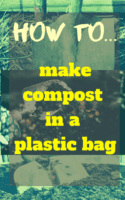Do your plants seem to take too long to grow? Are they looking sad and in need of some tender loving care? You may need to add compost to the soil to give your plants a good boost. Compost is what we can call a ‘beautiful mess’!
Here are the instructions to help you make your own compost to nourish your plants and give them the nutrients they need to grow. It’s simple and easy to make. Very importantly, this method is cost free!
Compost consists of two types of materials: the brown and green materials.
Brown materials: dead or dried leaves, small twigs, wood chips, coffee filters, shredded newspaper, straw, old and dried flowers, egg shells, etc.
Green materials: fruit and vegetable scraps, grass clippings, old tea bags, green/fresh leaves, etc.
Remember: Not everything can be used to make compost. Here’s a list of things that SHOULD NOT be included: cooked food, coal or charcoal ash, dairy products, insect-ridden plants, fats or grease or oils, meat or fish bones, pet waste (i.e. cat and dog faeces), garden trimmings that have been treated with pesticides.
Here’s what you’ll need to make your own compost in a plastic bag:
1. Two large black plastic bags
2. 1 bucket of brown materials
3. 1 bucket of green materials
4. 1 bucket of soil
5. Enough water to dampen the mixture
Preparation time: It will take you about 30 minutes to get the materials into the bags, but you’ll need to be patient for the brown and green materials to decompose properly to make the compost!
Directions:
• Collect your materials.
• In one of the plastic bags add first the brown materials.
• Next add the green materials.
• At the end add the soil.
• Remember that it is important that your layers are equal as this helps the compost to rot at the same time.
• Then add enough water to dampen the mixture.
• Close off your plastic bag with a string or any object that will make it easy for you to open your plastic bag without tearing it.
• Then put this plastic bag into the second plastic bag and close that off too with string or similar.
• Make sure your heap is not exposed to too much air.
• Position it where there is warmth.
• Turn compost material every two weeks by mixing the layers up a bit. But don’t add new material as your compost will not rot quickly if you do that
• After 8 weeks, check on your compost. You will know it’s ready when it turns dark, and has no remains food and waste and smells like the fresh compost you get at the nursery.
• If your compost looks unfinished then keep it in the plastic bags in a sunny spot until it looks just right.
Here is what compost looks like:

Stay tuned for more gardening tips; the next ‘How to’ gardening blog will be about how to grow a spinach seedling. It’s all about DIY!
Tell us : What do you think is the benefit of starting your home garden?


